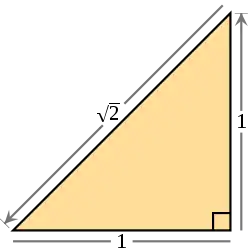Constructible number
In geometry and algebra, a real number is constructible if and only if, given a line segment of unit length, a line segment of length can be constructed with compass and straightedge in a finite number of steps. Equivalently, is constructible if and only if there is a closed-form expression for using only the integers 0 and 1 and the operations for addition, subtraction, multiplication, division, and square roots.

The geometric definition of constructible numbers motivates a corresponding definition of constructible points, which can again be described either geometrically or algebraically. A point is constructible if it can be produced (as an endpoint of a line segment or crossing point of two lines or circles) as one of the points of a compass and straight edge construction, starting from a given unit length segment. Alternatively and equivalently, taking the two endpoints of the segments to be the points (0,0) and (1,0) of a Cartesian coordinate system, a point is constructible if and only if its Cartesian coordinates are both constructible numbers.[1] Constructible numbers and points have also been called ruler and compass numbers and ruler and compass points, to distinguish them from numbers and points that may be constructed using other processes.[2]
The set of constructible numbers forms a field: applying any of the four basic arithmetic operations to members of this set produces another constructible number. This field is a field extension of the rational numbers and in turn is contained in the field of algebraic numbers. It is the Euclidean closure of the rational numbers, the smallest field extension of the rationals that includes the square roots of all of its positive numbers.[3]
The proof of the equivalence between the algebraic and geometric definitions of constructible numbers has the effect of transforming geometric questions about compass and straightedge constructions into algebra. This transformation leads to the solutions of many famous mathematical problems, which defied centuries of attack.
Geometric definitions
Geometrically constructible points
Let and be two given distinct points in the Euclidean plane, and define to be the set of points that can be constructed with compass and straightedge starting with and . Then the points of are called constructible points. and are, by definition, elements of . To more precisely describe the remaining elements of , make the following two definitions:[4]
- a line segment whose endpoints are in is called a constructed segment, and
- a circle whose center is in and which passes through a point of (alternatively, whose radius is the distance between some pair of distinct points of ) is called a constructed circle.
Then, the points of , besides and are:[4][5]
- the intersection of two non-parallel constructed segments, or lines through constructed segments,
- the intersection points of a constructed circle and a constructed segment, or line through a constructed segment, or
- the intersection points of two distinct constructed circles.
As an example, the midpoint of constructed segment is a constructible point. One construction for it is to construct two circles with as radius, and the line through the two crossing points of these two circles. Then the midpoint of segment is the point where this segment is crossed by the constructed line.
Geometrically constructible numbers
This geometric formulation can be used to define a Cartesian coordinate system in which the point is associated to the origin having coordinates and in which the point is associated with the coordinates . The points of may now be used to link the geometry and algebra by defining a constructible number to be a coordinate of a constructible point.[6]
Equivalent definitions are that a constructible number is the -coordinate of a constructible point [5] or the length of a constructible line segment.[7] If a constructible number is represented as the -coordinate of a constructible point , then the segment from to the perpendicular projection of onto line is a constructible line segment with length . And conversely, if is the length of a constructible line segment, then the intersection of line and a circle centered at with radius equal to the length of this segment gives a point whose first Cartesian coordinate is .
Given any two constructible numbers and , one can construct the points and as above, as the points at distances and from along line and its perpendicular axis through . Then, the point can be constructed as the intersection of two lines perpendicular to the axes through and . Therefore, the constructible points are exactly the points whose Cartesian coordinates are constructible numbers.[8]
Algebraic definitions
Algebraically constructible numbers
The algebraically constructible real numbers may be defined as the subset of real numbers that can be defined by a formula using the numbers 0 and 1 (or without any greater generality but with more concise formulas, arbitrary integers) and the operations of addition, subtraction, multiplication, multiplicative inverse, and square roots of positive numbers.[9]
Analogously, the algebraically constructible complex numbers may be defined as the subset of complex numbers constructed in the same way but using the principal square root of arbitrary complex numbers in place of the square root of positive real numbers. Alternatively, the same system of complex numbers may be defined as the complex numbers whose real and imaginary parts are both constructible real numbers.[10]
These two definitions of the constructible complex numbers are equivalent. In one direction, if is a complex number whose real part and imaginary part are both constructible real numbers, then substituting the formulas for and into the formula , and substituting for , produces a formula for as a complex number. In the other direction, any formula for an algebraically constructible complex number can be transformed into formulas for its real and imaginary parts, by recursively expanding each operation in the formula into operations on the real and imaginary parts of its arguments, using the expansions
- , where and .
Algebraically constructible points
The algebraically constructible points may be defined as the points whose two real Cartesian coordinates are both algebraically constructible real numbers. Alternatively, they may be defined as the points in the complex plane given by algebraically constructible complex numbers. By the equivalence between the two definitions for algebraically constructible complex numbers, these two definitions of algebraically constructible points are also equivalent.
Equivalence of algebraic and geometric definitions
If and are the non-zero lengths of constructed segments then elementary compass and straightedge constructions can be used to obtain constructed segments of lengths , , , and . The latter two can be done with a construction based on the intercept theorem. A slightly less elementary construction using these tools is based on the geometric mean theorem and will construct a segment of length from a constructed segment of length .[11]
It follows from these constructions that every algebraically constructible number is geometrically constructible.
In the other direction, a set of geometric objects may be specified by algebraically constructible real numbers: coordinates for points, slope and -intercept for lines, and center and radius for circles. It is possible (but tedious) to develop formulas in terms of these values, using only arithmetic and square roots, for each additional object that might be added in a single step of a compass-and-straightedge construction. It follows from these formulas that every geometrically constructible number is algebraically constructible.[12]
Algebraic properties
The definition of algebraically constructible numbers includes the sum, difference, product, and multiplicative inverse of any of these numbers, the same operations that define a field in abstract algebra. Thus, the constructive numbers (defined in any of the above ways) form a field. More specifically, the constructive real numbers form a Euclidean field, an ordered field containing a square root of each of its positive elements.[13] Examining the properties of this field and its subfields leads to necessary conditions on a number to be constructible, that can be used to show that specific numbers arising in classical geometric construction problems are not constructible.
It is convenient to consider, in place of the whole field of constructible numbers, the subfield generated by any given constructible number , and to use the algebraic construction of to decompose this field. If is a constructible real number, then the values occurring within a formula constructing it can be used to produce a finite sequence of real numbers such that, for each , is an extension of of degree 2.[14] Using slightly different terminology, a real number is constructible if and only if it lies in a field at the top of a finite tower of real quadratic extensions,
starting with the rational field where is in and for all , .[15] It follows from this decomposition that the degree of the field extension is , where counts the number of quadratic extension steps.
Analogously to the real case, a complex number is constructible if and only if it lies in a field at the top of a finite tower of complex quadratic extensions.[16] More precisely, is constructible if and only if there exists a tower of fields
where is in , and for all , . The difference between this characterization and that of the real quadratic numbers is only that the fields in this tower are not restricted to being real. Consequently, if a complex number is constructible, then is a power of two. However, this necessary condition is not sufficient: there exist field extensions whose degree is a power of two that cannot be factored into a sequence of quadratic extensions.[17]
The fields that can be generated in this way from towers of quadratic extensions of are called iterated quadratic extensions of . The fields of real and complex constructible numbers are the unions of all real or complex iterated quadratic extensions of .[18]
Trigonometric numbers
Trigonometric numbers are irrational cosines or sines of angles that are rational multiples of . Such a number is constructible if and only if the denominator of the fully reduced multiple is a power of 2 or the product of a power of 2 with the product of one or more distinct Fermat primes. Thus, for example, is constructible because 15 is the product of two Fermat primes, 3 and 5.
For a list of trigonometric numbers expressed in terms of square roots see trigonometric constants expressed in real radicals.
Impossible constructions

The ancient Greeks thought that certain problems of straightedge and compass construction they could not solve were simply obstinate, not unsolvable.[19] However, the non-constructibility of certain numbers proves them to be logically impossible to perform. (The problems themselves, however, are solvable using methods that go beyond the constraint of working only with straightedge and compass, and the Greeks knew how to solve them in this way.)
In the following chart, each table represents a specific ancient construction problem. The left column gives the name of the problem. The second column gives an equivalent algebraic formulation of the problem. In other words, the solution to the problem is affirmative if and only if each number in the given set of numbers is constructible. Finally, the last column provides a simple counterexample. In other words, the number in the last column is an element of the set in the same row, but is not constructible.
| Construction problem | Associated set of numbers | Counterexample |
|---|---|---|
| Doubling the cube | (the edge length of a doubled unit cube) is not constructible, because its minimal polynomial has degree 3 over Q[20] | |
| Trisecting the angle | (one of the coordinates of a unit-length segment trisecting an axis-aligned equilateral triangle) is not constructible, because has minimal polynomial of degree 3 over Q[20] | |
| Squaring the circle | (the side length of a square with the same area as a unit circle) is not constructible, because it is not algebraic over Q[20] | |
| Constructing regular polygons | (the x-coordinate of a vertex of an axis-aligned regular heptagon) is not constructible, because 7 is not a Fermat prime, nor is 7 the product of and one or more distinct Fermat primes[21] |
History
The birth of the concept of constructible numbers is inextricably linked with the history of the three impossible compass and straightedge constructions: duplicating the cube, trisecting an angle, and squaring the circle. The restriction of using only compass and straightedge in geometric constructions is often credited to Plato due to a passage in Plutarch. According to Plutarch, Plato gave the duplication of the cube (Delian) problem to Eudoxus and Archytas and Menaechmus, who solved the problem using mechanical means, earning a rebuke from Plato for not solving the problem using pure geometry (Plut., Quaestiones convivales VIII.ii, 718ef). However, this attribution is challenged,[22] due, in part, to the existence of another version of the story (attributed to Eratosthenes by Eutocius of Ascalon) that says that all three found solutions but they were too abstract to be of practical value.[23] Since Oenopides (circa 450 BCE) is credited with two ruler and compass constructions, by Proclus– citing Eudemus (circa 370 - 300 BCE)–when other methods were available to him, has led some authors to hypothesize that Oenopides originated the restriction.
The restriction to compass and straightedge is essential in making these constructions impossible. Angle trisection, for instance, can be done in many ways, several known to the ancient Greeks. The Quadratrix of Hippias of Elis, the conics of Menaechmus, or the marked straightedge (neusis) construction of Archimedes have all been used, as has a more modern approach via paper folding.
Although not one of the classic three construction problems, the problem of constructing regular polygons with straightedge and compass is usually treated alongside them. The Greeks knew how to construct regular n-gons with n = 2h, 3, 5 (for any integer h ≥ 2) or the product of any two or three of these numbers, but other regular n-gons eluded them. Then, in 1796, an eighteen-year-old student named Carl Friedrich Gauss announced in a newspaper that he had constructed a regular 17-gon with straightedge and compass.[24] Gauss's treatment was algebraic rather than geometric; in fact, he did not actually construct the polygon, but rather showed that the cosine of a central angle was a constructible number. The argument was generalized in his 1801 book Disquisitiones Arithmeticae giving the sufficient condition for the construction of a regular n-gon. Gauss claimed, but did not prove, that the condition was also necessary and several authors, notably Felix Klein,[25] attributed this part of the proof to him as well.[26]
Pierre Wantzel (1837) proved algebraically that the problems of doubling the cube and trisecting the angle are impossible to solve if one uses only compass and straightedge. In the same paper he also solved the problem of determining which regular polygons are constructible: a regular polygon is constructible if and only if the number of its sides is the product of a power of two and any number of distinct Fermat primes (i.e., the sufficient conditions given by Gauss are also necessary)
An attempted proof of the impossibility of squaring the circle was given by James Gregory in Vera Circuli et Hyperbolae Quadratura (The True Squaring of the Circle and of the Hyperbola) in 1667. Although his proof was faulty, it was the first paper to attempt to solve the problem using algebraic properties of π. It was not until 1882 that Ferdinand von Lindemann rigorously proved its impossibility, by extending the work of Charles Hermite and proving that π is a transcendental number.
The study of constructible numbers, per se, was initiated by René Descartes in La Géométrie, an appendix to his book Discourse on the Method published in 1637. Descartes associated numbers to geometrical line segments in order to display the power of his philosophical method by solving an ancient straightedge and compass construction problem put forth by Pappus.[27]
See also
Notes
- Kazarinoff (2003), pp. 10 & 15.
- Martin (1998), pp. 31–32.
- Kazarinoff (2003), p. 46.
- Kazarinoff (2003), p. 10.
- Martin (1998), Definition 2.1, pp. 30–31.
- Kazarinoff (2003), p. 18.
- Herstein (1986), p. 237.
- Moise (1974), p. 227; Martin (1998), Theorem 2.4, p. 33.
- Martin (1998), pages=36–37.
- Roman (1995), p. 207.
- Herstein (1986), pp. 236–237; Moise (1974), p. 224; Fraleigh (1994), pp. 426–427.
- Martin (1998), 38–39.
- Martin (1998), Theorem 2.7, p. 35.
- Fraleigh (1994), p. 429.
- Roman (1995), p. 59.
- Rotman (2006), p. 361.
- Rotman (2006), p. 362.
- Martin (1998), Theorem 2.10, p. 37.
- Stewart (1989), p. 51.
- Fraleigh (1994), pp. 429–430.
- Fraleigh (1994), p. 504.
- Kazarinoff (2003), p. 28.
- Knorr (1986), p. 4.
- Kazarinoff (2003), p. 29.
- Klein (1956), p. 16.
- Kazarinoff (2003), p. 30.
- Boyer (2004), pp. 83–88.
References
- Boyer, Carl B. (2004) [1956], History of Analytic Geometry, Dover, ISBN 978-0-486-43832-0
- Fraleigh, John B. (1994), A First Course in Abstract Algebra (5th ed.), Addison Wesley, ISBN 978-0-201-53467-2
- Herstein, I. N. (1986), Abstract Algebra, Macmillan, ISBN 0-02-353820-1
- Kazarinoff, Nicholas D. (2003) [1970], Ruler and the Round: Classic Problems in Geometric Constructions, Dover, ISBN 0-486-42515-0
- Klein, Felix (1956) [1930], Famous Problems of Elementary Geometry, Dover
- Knorr, Wilbur Richard (1986), The Ancient Tradition of Geometric Problems, Dover Books on Mathematics, Courier Dover Publications, ISBN 9780486675329
- Martin, George E. (1998), Geometric Constructions, Undergraduate Texts in Mathematics, Springer-Verlag, New York, doi:10.1007/978-1-4612-0629-3, ISBN 0-387-98276-0, MR 1483895
- Moise, Edwin E. (1974), Elementary Geometry from an Advanced Standpoint (2nd ed.), Addison Wesley, ISBN 0-201-04793-4
- Roman, Steven (1995), Field Theory, Springer-Verlag, ISBN 978-0-387-94408-1
- Rotman, Joseph J. (2006), A First Course in Abstract Algebra with Applications (3rd ed.), Prentice Hall, ISBN 978-0-13-186267-8
- Stewart, Ian (1989), Galois Theory (2nd ed.), Chapman and Hall, ISBN 978-0-412-34550-0
- Wantzel, P. L. (1837), "Recherches sur les moyens de reconnaître si un Problème de Géométrie peut se résoudre avec la règle et le compas", Journal de Mathématiques Pures et Appliquées, 1 (2): 366–372
External links
| Wikimedia Commons has media related to Constructible numbers. |
- Chris Cooper: Galois Theory. Lectures notes, Macquarie University, §6 Ruler and Compass Constructability, pp. 55-63
- Weisstein, Eric W., "Constructible Number", MathWorld
- Constructible Numbers at Cut-the-knot


